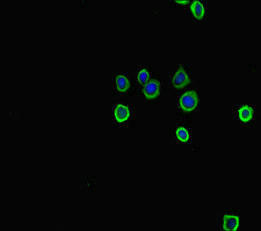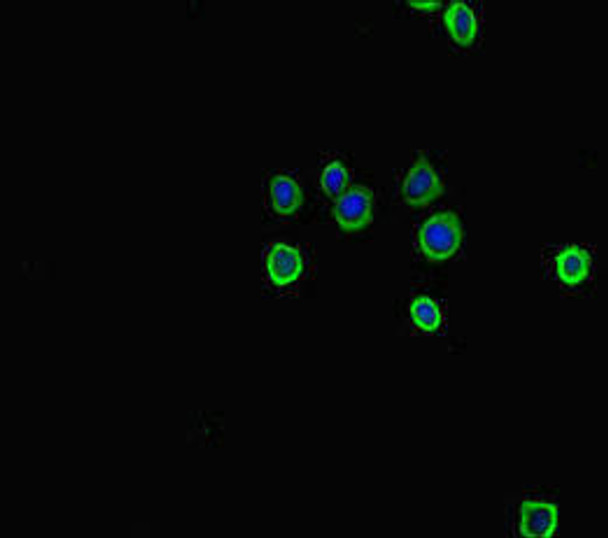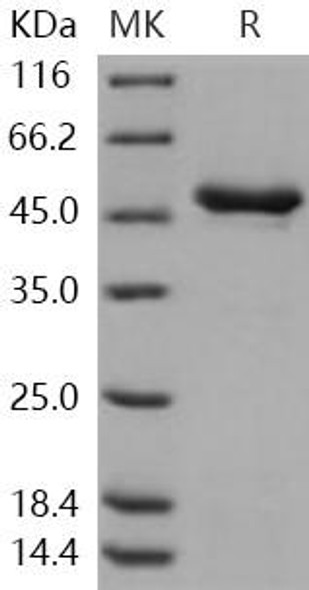Description
| Antibody Name: | Tph1 Antibody (PACO46294) |
| Antibody SKU: | PACO46294 |
| Size: | 50ug |
| Host Species: | Rabbit |
| Tested Applications: | ELISA, IF |
| Recommended Dilutions: | ELISA:1:2000-1:10000, IF:1:50-1:200 |
| Species Reactivity: | Mouse |
| Immunogen: | Recombinant Mouse Tryptophan 5-hydroxylase 1 protein (1-447AA) |
| Form: | Liquid |
| Storage Buffer: | Preservative: 0.03% Proclin 300 Constituents: 50% Glycerol, 0.01M PBS, PH 7.4 |
| Purification Method: | >95%, Protein G purified |
| Clonality: | Polyclonal |
| Isotype: | IgG |
| Conjugate: | Non-conjugated |
 | Immunofluorescent analysis of HepG2 cells using PACO46294 at dilution of 1:100 and Alexa Fluor 488-congugated AffiniPure Goat Anti-Rabbit IgG(H+L). |
| Background: | cytosol, indolalkylamine biosynthetic process |
| Synonyms: | Tryptophan 5-hydroxylase 1 (EC 1.14.16.4) (Tryptophan 5-monooxygenase 1), Tph1, Tph |
| UniProt Protein Function: | TPH1: an enzyme that is rate-limiting in the biosynthesis of serotonin. It catalyzes the biopterin dependent monooxygenation of tryptophan to 5-hydroxytryptophan (5HT), which is subsequently decarboxylated to form the neurotransmitter serotonin. Its expression is limited to a few specialized tissues: raphe neurons, pinealocytes, mast cells, mononuclear leukocytes, beta-cells of the islets of Langerhans, and intestinal and pancreatic enterochromaffin cells. Two alternatively spliced isoforms have been described. Protein type: Amino Acid Metabolism - tryptophan; EC 1.14.16.4; OxidoreductaseCellular Component: cytoplasm; neuron projectionMolecular Function: amino acid binding; iron ion binding; metal ion binding; monooxygenase activity; oxidoreductase activity; oxidoreductase activity, acting on paired donors, with incorporation or reduction of molecular oxygen, reduced pteridine as one donor, and incorporation of one atom of oxygen; tryptophan 5-monooxygenase activityBiological Process: aromatic amino acid family metabolic process; bone remodeling; metabolic process; negative regulation of ossification; positive regulation of fat cell differentiation; serotonin biosynthetic process |
| UniProt Protein Details: | |
| NCBI Summary: | This gene encodes a member of the biopterin-dependent aromatic amino acid hydroxylase family. The encoded protein is one of two tryptophan hydroxylase enzymes that catalyze the first and rate limiting step in the biosynthesis of the hormone and neurotransmitter, serotonin. This gene is expressed in peripheral organs, while tryptophan hydroxylase 2 is expressed in neurons. The encoded protein is involved in the development of hypoxia-induced elevations in pulmonary pressures and pulmonary vascular remodeling, and has also been implicated as a regulator of immune tolerance. Disruption of this gene is associated with cardiac dysfunction. Alternative splicing results in multiple transcript variants. [provided by RefSeq, Feb 2013] |
| UniProt Code: | P17532 |
| NCBI GenInfo Identifier: | 209862985 |
| NCBI Gene ID: | 21990 |
| NCBI Accession: | NP_001129556.1 |
| UniProt Secondary Accession: | P17532 |
| UniProt Related Accession: | P17532 |
| Molecular Weight: | 67.3 kDa |
| NCBI Full Name: | tryptophan 5-hydroxylase 1 isoform 1 |
| NCBI Synonym Full Names: | tryptophan hydroxylase 1 |
| NCBI Official Symbol: | Tph1 |
| NCBI Official Synonym Symbols: | Tph |
| NCBI Protein Information: | tryptophan 5-hydroxylase 1 |
| UniProt Protein Name: | Tryptophan 5-hydroxylase 1 |
| UniProt Synonym Protein Names: | Tryptophan 5-monooxygenase 1 |
| Protein Family: | Tryptophan 5-hydroxylase |
| UniProt Gene Name: | Tph1 |
| UniProt Entry Name: | TPH1_MOUSE |






